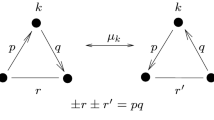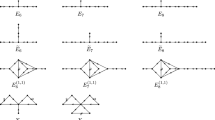Abstract
Motivated by the mutation theory of quivers with potentials developed by Derksen–Weyman–Zelevinsky, and the representation-theoretic approach to cluster algebras it provides, we propose a mutation theory of species with potentials for species that arise from skew-symmetrizable matrices that admit a skew-symmetrizer with pairwise coprime diagonal entries. The class of skew-symmetrizable matrices covered by the mutation theory proposed here contains a class of matrices that do not admit global unfoldings, that is, unfoldings compatible with all possible sequences of mutations.
Similar content being viewed by others
Notes
Which also go under the name of modulations of valued quivers.
This material has been added following a suggestion of an anonymous referee.
References
Berenstein, A., Fomin, S., Zelevinsky, A.: Cluster algebras III: upper bounds and double Bruhat cells. Duke Math. J. 126(1), 1–52 (2005). arXiv:math/0305434
Bernstein, J., Gelfand, I., Ponomarev, V.: Coxeter functors and Gabriel’s theorem. Uspehi Mat. Nauk 28(2) 19–33 (1973) [translated, Russian Math. Surveys 28, 17–32 (1973)]
Bridgeland, T., Smith, I.: Quadratic differentials as stability conditions. Publications mathématiques de l’IHÉS (2014). doi:10.1007/s10240-014-0066-5, arXiv:1302.7030
Irelli, Cerulli: G., Keller, B., Labardini-Fragoso, D., Plamondon, P.-G.: Linear independence of cluster monomials for skew-symmetric cluster algebras. Compos. Math. 149(10), 1753–1764 (2013). arXiv:1203.1307
Demonet, L.: Mutations of group species with potentials and their representations. Applications to cluster algebras. arXiv:1003.5078
Derksen, H., Weyman, J., Zelevinsky, A.: Quivers with potentials and their representations I: mutations. Selecta Math. 14(1), 59–119 (2008). arXiv:0704.0649
Derksen, H., Weyman, J., Zelevinsky, A.: Quivers with potentials and their representations II: applications to cluster algebras. J. Am. Math. Soc. 23(3), 749–790 (2010). arXiv:0904.0676
Dlab, V., Ringel, C.M.: Indecomposable representations of graphs and algebras. Mem. AMS 6(173) (1976)
Dupont, G.: An approach to non simply laced cluster algebras. J. Algebra 320(4), 1626–1661 (2008). arXiv:math/0512043
Felikson, A., Shapiro, M., Tumarkin, P.: Cluster algebras of finite mutation type via unfoldings. Int. Math. Res. Notices 8, 1768–1804 (2012). arXiv:1006.4276
Fomin, S., Zelevinsky, A.: \(Y\)-systems and generalized associahedra. Ann. Math. 158(3), 977–1018 (2003). arXiv:hep-th/0111053
Fomin, S., Zelevinsky, A.: Cluster algebras I: foundations. J. Am. Math. Soc. 15(2), 497–529 (2002). arXiv:math/0104151
Fomin, S., Zelevinsky, A.: Cluster algebras II: finite type classification. Invent. Math. 154(1), 63–121 (2003). arXiv:math.RA/0208229
Fomin, S., Zelevinsky, A.: Cluster algebras IV: coefficients. Compos. Math. 143, 112–164 (2007). arXiv:math/0602259
Gabriel, P.: Indecomposable representations, II. Symp. Math. Inst. Nazionale Alta Mat. (Rome) 11, 81–104 (1973)
Geuenich, J., Labardini-Fragoso, D.: Species with potential associated to triangulated surfaces with orbifold points of order 2 (in preparation)
Keller, B.: The periodicity conjecture for pairs of Dynkin diagrams. Ann. Math. 177(1) (2013)
Labardini-Fragoso, D.: Quivers with potentials associated to triangulated surfaces. Proc. Lond. Math. Soc. 98(3), 797–839 (2009). arXiv:0803.1328
Labardini-Fragoso, D.: Quivers with potentials associated to triangulated surfaces. Part IV: removing boundary assumptions. arXiv:1206.1798
Marsh, R., Reineke, M., Zelevinsky, A.: Generalized associahedra via quiver representations. Trans. Am. Math. Soc. 355, 4171–4186 (2003). arXiv:math/0205152
Nagao, K.: Donaldson–Thomas theory and cluster algebras. Duke Math. J. 162(7), 1313–1367 (2013). arXiv:1002.4884
Nguefack, B.: Modulated quivers with potentials and their Jacobian algebras. arXiv:1004.2213
Plamondon, P.-G.: Cluster algebras via cluster categories with infinite-dimensional morphism spaces. Compos. Math. 147, 1921–1954 (2011). arXiv:1004.0830
Rupel, D.: On a quantum analogue of the Caldero–Chapoton formula. Int. Math. Res. Notices 14, 3207–3236 (2011). arXiv:1003.2652
Rupel, D.: Quantum cluster characters. arXiv:1109.6694
Speyer, D., Thomas, H.: Acyclic cluster algebras revisited. arXiv:1203.0277
Speyer, D., Zelevinsky, A.: Unpublished example of a skew-symmetrizable matrix without global unfoldings
Zelevinsky, A.: Unpublished definition of global unfoldings of skew-symmetrizable matrices
Acknowledgments
The collaborations [6, 7] of Harm Derksen and Jerzy Weyman with A. Zelevinsky have served as an inspiring and guiding source throughout the development of the present manuscript. We have made a conscious effort to follow [6] as much as possible, both in the structure of the paper, and in the form and proofs of the results. We thank Laurent Demonet, Claus Michael Ringel and Dylan Rupel for helpful discussions. We are particularly grateful to David Speyer for his collaboration [27] with A. Zelevinsky that showed the existence of skew-symmetrizable matrices without global unfoldings. D. Labardini-Fragoso thanks the Representation theory group of the National Autonomous University of Mexico, especially Michael Barot and Christof Geiss, for their hospitality and financial support during his several visits to UNAM’s Institute of Mathematics in Mexico City. Parts of the work presented here were completed in these visits. This project started several years ago, when D. Labardini-Fragoso was a Ph.D. student of A. Zelevinsky at Northeastern University’s Department of Mathematics (Boston, MA, USA). Unfortunately, Professor Andrei Zelevinsky passed away during the last stage of the preparation of this paper. D. Labardini-Fragoso is sincerely grateful to him for his enthusiasm and deep insights and contributions throughout the collaboration that led to the present paper. It is needless to say that any possible inaccuracies or mistakes should be attributed to D. Labardini-Fragoso alone. D. Labardini-Fragoso wishes to thank an anonymous referee for his/her thorough reading and a number of remarks and suggestions.
Author information
Authors and Affiliations
Corresponding author
Additional information
A. Zelevinsky passed away on April 10, 2013.
Rights and permissions
About this article
Cite this article
Labardini-Fragoso, D., Zelevinsky, A. Strongly primitive species with potentials I: mutations. Bol. Soc. Mat. Mex. 22, 47–115 (2016). https://doi.org/10.1007/s40590-015-0063-9
Received:
Accepted:
Published:
Issue Date:
DOI: https://doi.org/10.1007/s40590-015-0063-9




